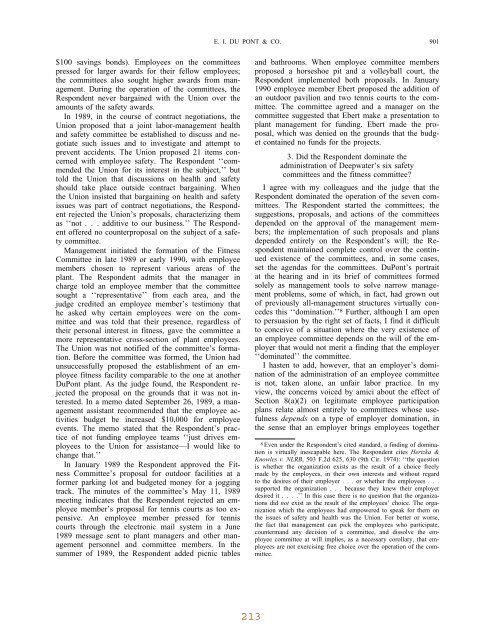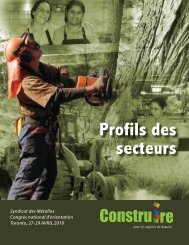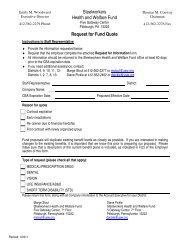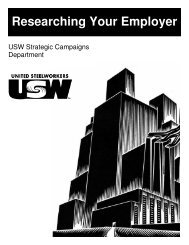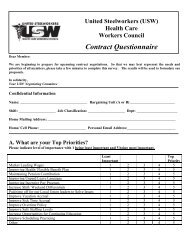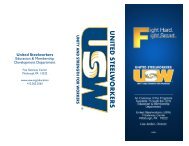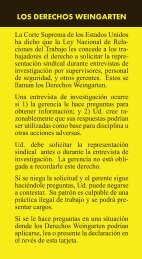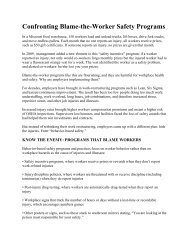Union Approach to Health and Safety: - United Steelworkers
Union Approach to Health and Safety: - United Steelworkers
Union Approach to Health and Safety: - United Steelworkers
You also want an ePaper? Increase the reach of your titles
YUMPU automatically turns print PDFs into web optimized ePapers that Google loves.
E. I. DU PONT & CO.<br />
901<br />
$100 savings bonds). Employees on the committees<br />
pressed for larger awards for their fellow employees;<br />
the committees also sought higher awards from management.<br />
During the operation of the committees, the<br />
Respondent never bargained with the <strong>Union</strong> over the<br />
amounts of the safety awards.<br />
In 1989, in the course of contract negotiations, the<br />
<strong>Union</strong> proposed that a joint labor-management health<br />
<strong>and</strong> safety committee be established <strong>to</strong> discuss <strong>and</strong> negotiate<br />
such issues <strong>and</strong> <strong>to</strong> investigate <strong>and</strong> attempt <strong>to</strong><br />
prevent accidents. The <strong>Union</strong> proposed 21 items concerned<br />
with employee safety. The Respondent ‘‘commended<br />
the <strong>Union</strong> for its interest in the subject,’’ but<br />
<strong>to</strong>ld the <strong>Union</strong> that discussions on health <strong>and</strong> safety<br />
should take place outside contract bargaining. When<br />
the <strong>Union</strong> insisted that bargaining on health <strong>and</strong> safety<br />
issues was part of contract negotiations, the Respondent<br />
rejected the <strong>Union</strong>’s proposals, characterizing them<br />
as ‘‘not . . . additive <strong>to</strong> our business.’’ The Respondent<br />
offered no counterproposal on the subject of a safety<br />
committee.<br />
Management initiated the formation of the Fitness<br />
Committee in late 1989 or early 1990, with employee<br />
members chosen <strong>to</strong> represent various areas of the<br />
plant. The Respondent admits that the manager in<br />
charge <strong>to</strong>ld an employee member that the committee<br />
sought a ‘‘representative’’ from each area, <strong>and</strong> the<br />
judge credited an employee member’s testimony that<br />
he asked why certain employees were on the committee<br />
<strong>and</strong> was <strong>to</strong>ld that their presence, regardless of<br />
their personal interest in fitness, gave the committee a<br />
more representative cross-section of plant employees.<br />
The <strong>Union</strong> was not notified of the committee’s formation.<br />
Before the committee was formed, the <strong>Union</strong> had<br />
unsuccessfully proposed the establishment of an employee<br />
fitness facility comparable <strong>to</strong> the one at another<br />
DuPont plant. As the judge found, the Respondent rejected<br />
the proposal on the grounds that it was not interested.<br />
In a memo dated September 26, 1989, a management<br />
assistant recommended that the employee activities<br />
budget be increased $10,000 for employee<br />
events. The memo stated that the Respondent’s practice<br />
of not funding employee teams ‘‘just drives employees<br />
<strong>to</strong> the <strong>Union</strong> for assistance—I would like <strong>to</strong><br />
change that.’’<br />
In January 1989 the Respondent approved the Fitness<br />
Committee’s proposal for outdoor facilities at a<br />
former parking lot <strong>and</strong> budgeted money for a jogging<br />
track. The minutes of the committee’s May 11, 1989<br />
meeting indicates that the Respondent rejected an employee<br />
member’s proposal for tennis courts as <strong>to</strong>o expensive.<br />
An employee member pressed for tennis<br />
courts through the electronic mail system in a June<br />
1989 message sent <strong>to</strong> plant managers <strong>and</strong> other management<br />
personnel <strong>and</strong> committee members. In the<br />
summer of 1989, the Respondent added picnic tables<br />
<strong>and</strong> bathrooms. When employee committee members<br />
proposed a horseshoe pit <strong>and</strong> a volleyball court, the<br />
Respondent implemented both proposals. In January<br />
1990 employee member Ebert proposed the addition of<br />
an outdoor pavilion <strong>and</strong> two tennis courts <strong>to</strong> the committee.<br />
The committee agreed <strong>and</strong> a manager on the<br />
committee suggested that Ebert make a presentation <strong>to</strong><br />
plant management for funding. Ebert made the proposal,<br />
which was denied on the grounds that the budget<br />
contained no funds for the projects.<br />
3. Did the Respondent dominate the<br />
administration of Deepwater’s six safety<br />
committees <strong>and</strong> the fitness committee?<br />
I agree with my colleagues <strong>and</strong> the judge that the<br />
Respondent dominated the operation of the seven committees.<br />
The Respondent started the committees; the<br />
suggestions, proposals, <strong>and</strong> actions of the committees<br />
depended on the approval of the management members;<br />
the implementation of such proposals <strong>and</strong> plans<br />
depended entirely on the Respondent’s will; the Respondent<br />
maintained complete control over the continued<br />
existence of the committees, <strong>and</strong>, in some cases,<br />
set the agendas for the committees. DuPont’s portrait<br />
at the hearing <strong>and</strong> in its brief of committees formed<br />
solely as management <strong>to</strong>ols <strong>to</strong> solve narrow management<br />
problems, some of which, in fact, had grown out<br />
of previously all-management structures virtually concedes<br />
this ‘‘domination.’’ 8 Further, although I am open<br />
<strong>to</strong> persuasion by the right set of facts, I find it difficult<br />
<strong>to</strong> conceive of a situation where the very existence of<br />
an employee committee depends on the will of the employer<br />
that would not merit a finding that the employer<br />
‘‘dominated’’ the committee.<br />
I hasten <strong>to</strong> add, however, that an employer’s domination<br />
of the administration of an employee committee<br />
is not, taken alone, an unfair labor practice. In my<br />
view, the concerns voiced by amici about the effect of<br />
Section 8(a)(2) on legitimate employee participation<br />
plans relate almost entirely <strong>to</strong> committees whose usefulness<br />
depends on a type of employer domination, in<br />
the sense that an employer brings employees <strong>to</strong>gether<br />
8 Even under the Respondent’s cited st<strong>and</strong>ard, a finding of domination<br />
is virtually inescapable here. The Respondent cites Hertzka &<br />
Knowles v. NLRB, 503 F.2d 625, 630 (9th Cir. 1974): ‘‘the question<br />
is whether the organization exists as the result of a choice freely<br />
made by the employees, in their own interests <strong>and</strong> without regard<br />
<strong>to</strong> the desires of their employer . . . or whether the employees . . .<br />
supported the organization . . . because they knew their employer<br />
desired it . . . .’’ In this case there is no question that the organizations<br />
did not exist as the result of the employees’ choice. The organization<br />
which the employees had empowered <strong>to</strong> speak for them on<br />
the issues of safety <strong>and</strong> health was the <strong>Union</strong>. For better or worse,<br />
the fact that management can pick the employees who participate,<br />
counterm<strong>and</strong> any decision of a committee, <strong>and</strong> dissolve the employee<br />
committee at will implies, as a necessary corollary, that employees<br />
are not exercising free choice over the operation of the committee.


